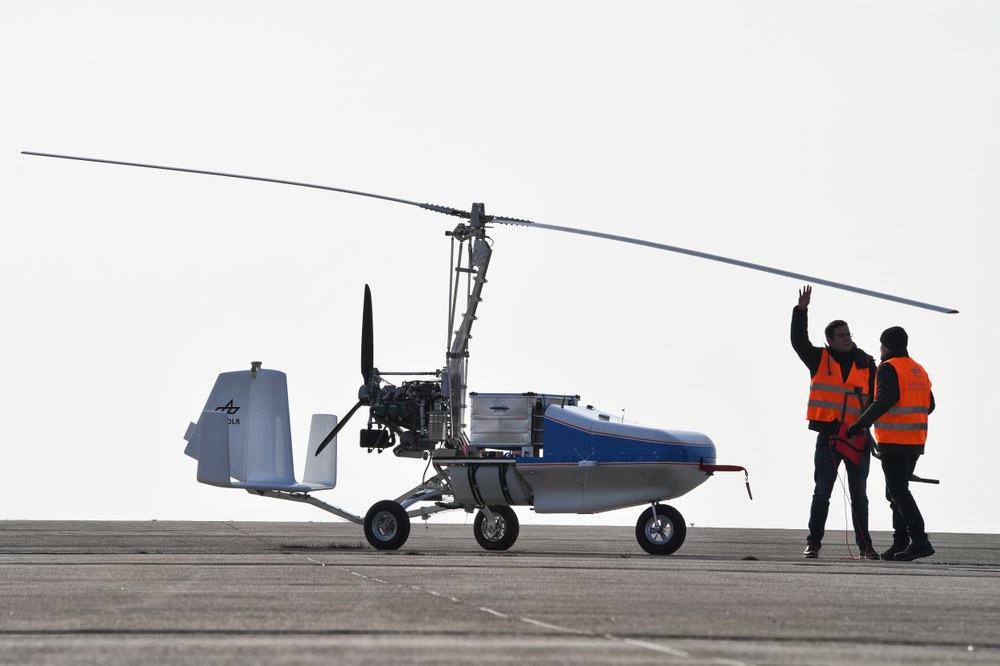Realisation of a prototype: ALAADy demonstrator


The ALAADy and ALAADy Demonstrator projects, launched in 2016, are investigating the theoretical and practical aspects of automatic and unmanned air transport. To this end, the best possible aircraft configurations for automatic air cargo transport were first determined by evaluating fixed- and rotary-wing aircraft in terms of flight performance and characteristics. In order to be able to realize a prototype as quickly as possible to learn from practical applications, a configuration that could be realized in the short term was selected.
A gyroplane is automated
Equipping an aircraft with actuators and electronics is not uncommon these days. What is new is the equipping of a manned gyroplane with a control system that allows fully autonomous flight. In principle, the ALAADy demonstrator is a giant flying model - but full-size! However, a special challenge in the development of this prototype is actually the actuators - i.e. the motors that realize the control in flight. Special motors suitable for this purpose were selected and extensively tested before installation. When selecting the motors, the main task was to find a compromise between weight, adjustment speed, power and energy consumption. The availability of suitable actuators was followed by the selection of the computers, which are to establish a connection to the pilot safely and reliably. Computers only fulfill their actual function with software. The software is a kind of work instruction for the computer. Programming these instructions is a laborious and complex task, especially if the software is to be reliable enough to take control of an aircraft. Of course, researchers can think of many other tasks that such a computer should perform. In the end, several computers were installed so that the tasks could be grouped according to their importance for flight.
The ALAADy demonstrator is a gyroplane based on the MTOfree model from AutoGyro in Hildesheim. It has a Rotax combustion engine which generates the necessary propulsion with its 100 hp. Lift is generated by a rotor with a diameter of 8.4 m, which is not driven in flight and which turns on its own as a result of the air flow, just like a wind turbine. For the realization of a "transport drone" as a technology demonstrator, special attention was paid to the safety aspects, the operational constraints, the system architecture and the necessary capabilities. Gyrocopters have the special property of inherent safety, as the freely rotating rotor allows a soft landing, like on a parachute, in case of failure.
It is a distant goal of the researchers that the aircraft will be able to fly autonomously over long distances and that they will only have to intervene in an emergency
The multiple failure-proof architectures classically used in aircraft construction were intentionally not used, since a failure of individual components or even of the entire control system does not or should not have any influence on the operational safety of the demonstrator. The concept behind this initially contradictory requirement is a procedure for operating unmanned aerial vehicles that has been established for some time. Unmanned aerial vehicles are usually not safeguarded against failures of individual components for cost reasons and because of the comparatively small payload. Instead, safe operation is achieved through limitations in flight operations. Such restrictions may include limitations in flight altitude, operation within visual range, or the establishment of a restricted flight area. The operator will outline how operational safety will be achieved or how violation of the limitations will be prevented as part of their application for a specific ascent permit. A crash may therefore become an economic risk that can be considered independently of operational safety. The process is structured by a procedure known as SORA (Specific Operational Risk Analysis). This concept of a mission-based flight clearance for unmanned aerial vehicles is intended to balance the need for safety with the economic operation of unmanned aerial vehicles. DLR is currently evaluating concepts and building demonstrators for the transport of cargo at low altitudes over sparsely populated areas.
DLR is a neutral pioneer of civil research topics in unmanned aeronautics
The maiden flight was preceded by a rollout on Feb. 20, 2018. This official presentation of the aircraft marked the start of numerous system and taxi tests in which the aircraft was pre-tested as far as possible. Among other things, these tests examined whether the aircraft could be accelerated and braked safely - certainly one of the most important prerequisites for being able to realize a maiden flight. In addition, numerous sensor data were analysed and control parameters optimised. After all, even in the event of a not entirely improbable incident during the maiden flight, sufficient data should be available to analyse the cause.
The vision is to enable safe, cost-effective, feasible, compatible, integrated automated air transportation in civil airspace.
Project | ALAADy Demonstrator |
|---|---|
Period: | 2016-2019 |
DLR institutes and facilities: |
